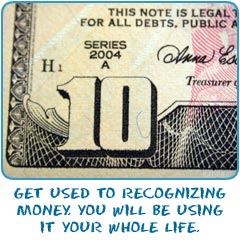
The Money in Your Pocket
You may or may not have some money in your pocket right now. We hope you have a little saved away even if it's not in your pocket. Doing anything in the world is super tough without money. You don't need a lot to be happy, but you do need some to live a nice life. If you're a hermit living in a cave, money doesn't matter. But if you are a hermit living in a cave, you're probably not looking at this web site.In your pocket, no matter what country you are in, you could have any combination of paper money and coins. Paper money usually represents larger values and coins represent smaller values. The United States has traditionally green paper money (with some new variations). These bills represent whole numbers of dollars. Dollars and cents are the two names applied to the U.S. money system. Dollars are whole numbers, while cents are amounts of money less than one dollar. The cents are the coins of the U.S. money system. We have one hundred cents in every dollar. That works out great if you are doing math with money. It's the same process as working with decimals.
RELATED ACTIVITIES

|
Count and Figure Value of Half-Dollars
- Play Activity |

|
"Do You Have Enough Money?" - Values Less Than One Dollar
- Play Activity |
A World of Coins
The United States has a few basic choices of metal coins. These coins can be used in any combination to make larger values. The coins include:Penny - Value $0.01
Nickel - Value $0.05
Dime - Value $0.10
Quarter - Value $0.25
Half Dollar - Value $0.50
Dollar - Value $1.00
We also have special silver, gold, and platinum coins that have printed values, but they are worth much more than those amounts. A fifty-dollar gold piece can be worth over a thousand dollars. Collectors usually buy the coins made with precious metals. They don't carry them around in their pockets to buy a burrito at a food truck.
A World of Paper
If you need to buy something worth one hundred dollars, you don't want to carry around coins. To make life a little easier, the U.S. Mint prints paper money in different dollar amounts. We should mention that if you rip a bill in half, it is not worth half of its value. You need the whole bill to make it valuable. Here is a list of the common paper money:One Dollar Bill - Value $1.00
Five Dollar Bill - Value $5.00
Ten Dollar Bill - Value $10.00
Twenty Dollar Bill - Value $20.00
Fifty Dollar Bill - Value $50.00
One Hundred Dollar Bill - Value $100.00
You will rarely see other bills, but they are out there. The U.S. Mint has printed two-dollar bills, but those are rare. There are also big values such as $500, $1,000, $5,000, and $10, 000 bills that you won't see around every day. They were important before banks started using computers to transfer money. The largest bill ever printed was a $100,000 bill in 1934. We know you won't find one of those at your ATM.
RELATED ACTIVITIES

|
Add Coins with Values Less Than One Dollar
- Play Activity |

|
"Do You Have Enough Money?"More or Less?"Do You Have Enough Money?" - Values Less Than Thirty Cents
- Play Activity |
► NEXT PAGE ON FRACTIONS & DECIMALS
► NEXT STOP ON SITE TOUR
► RETURN TO TOP OF PAGE
► Or search the sites...
► NEXT STOP ON SITE TOUR
► RETURN TO TOP OF PAGE
► Or search the sites...

- Overview
- Number Types
- Factors
- Fractions
- Decimals
- Percentages
- Estimation
- Ratios
- Money
- Activities
- More Maths Topics

Useful Reference Materials
Wikipedia:https://en.wikipedia.org/wiki/Fraction_%28mathematics%29
Encyclopædia Britannica:
http://www.britannica.com/topic/fraction
University of Delaware:
https://sites.google.com/a/udel.edu/fractions/


